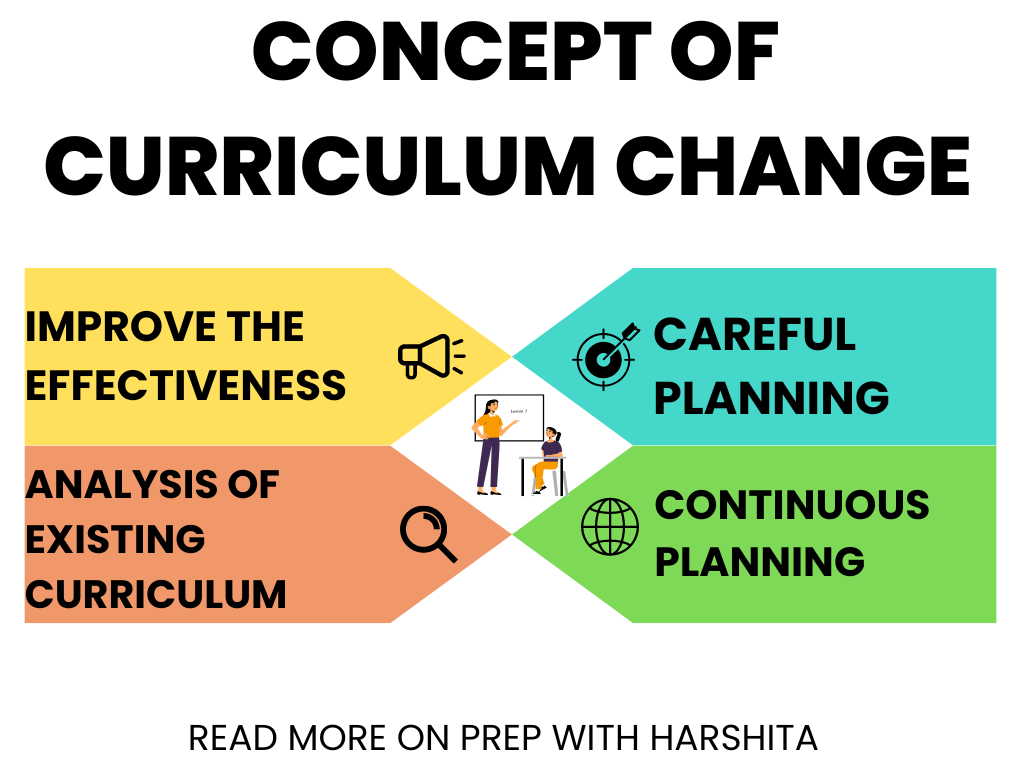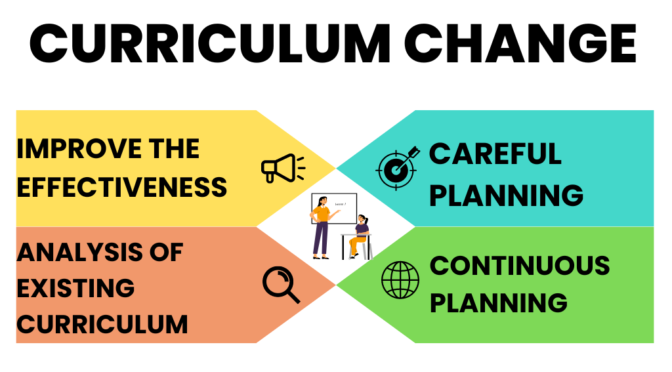Curriculum change refers to the process of modifying, revising, or updating the content, structure, and delivery of a curriculum.
- Curriculum change is often driven by various factors such as changes in societal needs, advancements in technology, new knowledge and research, and shifts in student demographics and learning styles.
- The purpose of this is to improve the effectiveness of education and to better align it with the needs of students, society, and the workforce.
- The process of change involves a thorough analysis of the existing curriculum, identification of the strengths and weaknesses, and the development of a plan for modifying or updating the curriculum.
- It can be a complex and challenging process that requires the involvement of various stakeholders such as educators, administrators, subject matter experts, students, and parents.
- Effective change also requires careful planning and implementation, ongoing evaluation, and continuous improvement.
- There are several models of curriculum change that can be used to guide the process, such as the Lewin’s Change Model, which involves three stages: unfreezing, changing, and refreezing. This model emphasizes the importance of creating a sense of urgency, involving stakeholders, and reinforcing the change to ensure that it becomes part of the new curriculum.
The following are the steps involved in curriculum change:
- Needs assessment: It typically begins with an assessment of current needs and an analysis of the strengths and weaknesses of the existing curriculum. This may involve data gathering, consultations with stakeholders, and a review of current research and best practices.
- Goal setting: Once the needs have been identified, the next step is to establish clear goals and objectives for the It. These goals and objectives should be specific, measurable, achievable, relevant, and time-bound (SMART).
- Planning: It requires a well-designed plan that outlines the steps and strategies for implementing the changes. The plan should include a timeline, resources needed, and the roles and responsibilities of stakeholders.
- Implementation: The next step is to implement the changes to the curriculum. This may involve the development of new course materials, changes to teaching methods and approaches, and the adoption of new technologies.
- Evaluation: It should be evaluated regularly to ensure that it is achieving its goals and objectives. This may involve data gathering, assessments of student learning outcomes, and feedback from stakeholders.
- Continuous improvement: Based on the evaluation, the it may need to be revised, modified, or updated to ensure that it remains relevant and effective.
Curriculum change can be a complex and challenging process that requires the involvement of various stakeholders such as educators, administrators, subject matter experts, students, and parents. It also requires careful planning and implementation, ongoing evaluation, and continuous improvement.
Also Read : Factors Influencing Curriculum change

Also Visit : Prep with Harshita


Best private proxies and best proxy prices – buy cheap proxy with https://DreamProxies.com
First of all, your website is very nice. Also, the articles are very great. I visit your site regularly. Thank you.
It is appropriate time to make a few plans for the long run and it’s time to be happy. I have learn this publish and if I may just I want to recommend you few attention-grabbing things or tips. Maybe you can write next articles regarding this article. I desire to learn more things about it!
Way cool, some valid points! I appreciate you making this article available, the rest of the site is also high quality. Have a fun.
I really like your blog.. very nice colors & theme. Did you make this website yourself or did you hire someone to do it for you? Plz respond as I’m looking to design my own blog and would like to find out where u got this from. cheers
I like the valuable information you provide in your articles. I’ll bookmark your weblog and check again here regularly. I am quite sure I will learn lots of new stuff right here! Good luck for the next!
I really appreciate this post. I have been looking everywhere for this! Thank goodness I found it on Bing. You’ve made my day! Thanks again